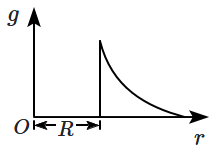A body of mass \(60~ \text{g}\) experiences a gravitational force of \(3.0~\text{N}\) when placed at a particular point. The magnitude of the gravitational field intensity at that point is:
| 1. | \(180 ~\text{N/kg}\) | 2. | \(0.05 ~\text{N/kg}\) |
| 3. | \(50 ~\text{N/kg}\) | 4. | \(20 ~\text{N/kg}\) |
Subtopic: Gravitational Field |
73%
From NCERT
NEET - 2022
To view explanation, please take trial in the course.
NEET 2026 - Target Batch - Vital
Hints
To view explanation, please take trial in the course.
NEET 2026 - Target Batch - Vital
In a gravitational field, the gravitational potential is given by; \(V=-\frac{K}{x}~\text{J/kg}.\) The gravitational field intensity at the point \((2,0,3)~\text m\) is:
| 1. | \(+\dfrac K2\) | 2. | \(-\dfrac{K}{2}\) |
| 3. | \(-\dfrac{K}{4}\) | 4. | \(+\dfrac K4\) |
Subtopic: Gravitational Field |
From NCERT
NEET - 2022
To view explanation, please take trial in the course.
NEET 2026 - Target Batch - Vital
Hints
To view explanation, please take trial in the course.
NEET 2026 - Target Batch - Vital
Dependence of intensity of gravitational field \((\mathrm{E})\) of the earth with distance \((\mathrm{r})\) from the centre of the earth is correctly represented by: (where \(\mathrm{R}\) is the radius of the earth)
| 1. |  |
2. |  |
| 3. |  |
4. |  |
Subtopic: Gravitational Field |
66%
From NCERT
AIPMT - 2014
To view explanation, please take trial in the course.
NEET 2026 - Target Batch - Vital
Hints
Links
To view explanation, please take trial in the course.
NEET 2026 - Target Batch - Vital
Which one of the following plots represents the variation of a gravitational field on a particle with distance \(r\) due to a thin spherical shell of radius \(R?\)
(\(r\) is measured from the centre of the spherical shell)
| 1. |  |
2. |  |
| 3. |  |
4. |  |
Subtopic: Gravitational Field |
75%
From NCERT
AIPMT - 2012
To view explanation, please take trial in the course.
NEET 2026 - Target Batch - Vital
Hints
Links
To view explanation, please take trial in the course.
NEET 2026 - Target Batch - Vital
If the radius of the earth shrinks by 1%, then for acceleration due to gravity, there would be:
1. No change at the poles
2. No change at the equator
3. Maximum change at the equator
4. Equal change at all locations
Subtopic: Gravitational Field | Acceleration due to Gravity |
From NCERT
AIPMT - 1999
To view explanation, please take trial in the course.
NEET 2026 - Target Batch - Vital
Hints
To view explanation, please take trial in the course.
NEET 2026 - Target Batch - Vital


